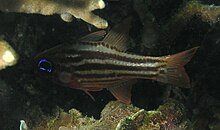Ostorhinchus compressus
| Ostorhinchus compressus | |
|---|---|

| |
| Scientific classification | |
| Domain: | Eukaryota |
| Kingdom: | Animalia |
| Phylum: | Chordata |
| Class: | Actinopterygii |
| Order: | Kurtiformes |
| Family: | Apogonidae |
| Genus: | Ostorhinchus |
| Species: | O. compressus
|
| Binomial name | |
| Ostorhinchus compressus (H. M. Smith & Radcliffe, 1911)
| |
| Synonyms | |
| |
Ostorhinchus compressus, commonly called the ochre-striped cardinalfish, blue-eyed cardinalfish or split banded cardinalfish, is a marine cardinalfish from the Indo-West Pacific from the family Apogonidae. It occasionally makes its way into the aquarium trade. It grows to a size of 12 cm in length.
Taxonomy[edit]
This fish was first described by Hugh McCormick Smith and Lewis Radcliffe after its collection during the 1907-1910 United States Bureau of Fisheries Albatross Philippines expedition.[2] The holotype (record number USNM 68398) is lodged at the Smithsonian in Washington, D.C.[3]
Etymology[edit]
The genus Amia initially allocated by the authors subsequently proved to be a synonym of Ostorhinchus, making its way via Apogon.[4]
Description[edit]
Although the maximum recorded standard length of O. compressus is 12 cm, its most common adult length is around 8.5 cm. Adults are pinkish-white, with six brown stripes along each side, iridescent blue eye rings, and up to four brown spots on the caudal peduncle (tail base). Juveniles begin with a black spot on a yellow caudal peduncle, which appears to mimic juveniles of certain piscivorous species of Cheilodipterus.[5]

Meristics[edit]
Using a shorthand meristics formula, O. compressus can be described as having:
D, VI-I,9
A II,9
P, 13-14
LL, 24
GR, 7-8 + 20-22[6]
Distribution and habitat[edit]
Range[edit]
Ostorhinchus compressus occurs in Australian waters from the Scott Reef, Ashmore and Cartier Islands, and Rowley Shoals in Western Australia; and from the Great Barrier Reef to the Middleton & Elizabeth Reefs Reserve and Lord Howe Island in the Tasman Sea. Its wider distribution extends through the Indo-Pacific from the Andaman Sea to Vanuatu and New Caledonia and as far north as southern Japan.[7]
Ontology[edit]
Research on the larval stage of this species shows that as it develops, its ability to see in ultraviolet light increases. Given that the larval stage is pelagic, this implies that older larvae can migrate down the water column to feed.[8] This might improve its predator evasion, whilst improving its food intake.
Settlement[edit]
Generally found from 2–20 metres, adults rest during the daytime in floating mixed species groups with other Apogonids. They are not very picky, being found resting in association with several kinds of live hard coral, Gorgonians, dead coral, rubble, and sand.[9] Possibly because of the low water circulation, higher temperatures, and high oxygen consumption of some of the shallow branching corals into which O. compressus retreats from predators, it has been found to tolerate very low dissolved levels of oxygen, even at a temperature of 30 °C (which is likely to stimulate a relatively high resting metabolic rate).[10]
Parasites[edit]
The gills of O. compressus have been found infected with Gyrodactylid flatworms.[11]
References[edit]
- ^ Allen, G.R. & Fricke, R. (2010). "Apogon compressus". The IUCN Red List of Threatened Species. 2010: e.T154872A4656289. doi:10.2305/IUCN.UK.2010-4.RLTS.T154872A4656289.en.
- ^ Radcliffe, L. (1911): Notes on some fishes of the genus Amia, family of Cheilodipteridae, with descriptions of four new species from the Philippine Islands. (Scientific results of the Philippine cruise of the Fisheries steamer "Albatross," 1907-1910.--No. 12.) Proceedings of the United States National Museum v. 41 (no. 1853): 245-261, Pls. 20-25
- ^ USNM records search
- ^ Eschmeyer, William N.; Fricke, Ron & van der Laan, Richard (eds.). "Ostorhinchus compressus". Catalog of Fishes. California Academy of Sciences. Retrieved 22 September 2018.
- ^ Froese, Rainer; Pauly, Daniel (eds.) (2018). "Ostorhinchus commpressus" in FishBase. June 2018 version.
- ^ Allen, G.R. and M.V. Erdmann 2012 Reef fishes of the East Indies. Tropical Reef Research, Perth, Australia. Volume I, p. 390.
- ^ Dianne J. Bray. "Ostorhinchus compressus". Fishes of Australia. Museums Victoria. Retrieved 22 September 2018.
- ^ Job S. D. & J. Shand (2001). "Spectral sensitivity of larval and juvenile coral reef fishes: implications for feeding in a variable light environment" (PDF). Marine Ecology Progress Series. 214: 267–277. doi:10.3354/meps214267.
- ^ Gardiner N. M. & G. P. Jones (2005). "Habitat specialisation and overlap in a guild of coral reef cardinalfishes (Apogonidae)" (PDF). Marine Ecology Progress Series. 305: 163–175. doi:10.3354/meps305163.
- ^ Nilsson, G. E. & Ostlund-Nilsson, S. (2006). "Hypoxia tolerance in coral reef fishes". In Val, A. L.; Almeida-Val, V. M. F. & D. J. Randall (eds.). The Physiology of Tropical Fishes. Elsevier. pp. 583–596. ISBN 9780123504456.
- ^ Ernst I.; I. D. Whittington & M. K. Jones (2001). "Diversity of gyrodactylids from some marine fishes in tropical and subtropical Queensland, Australia" (PDF). Folia Parasitologica. 48 (2): 165–168. doi:10.14411/fp.2001.028. PMID 11437134.
External links[edit]
- Photos of Ostorhinchus compressus on Sealife Collection

